Hindu Rituals
Engagement Ceremony
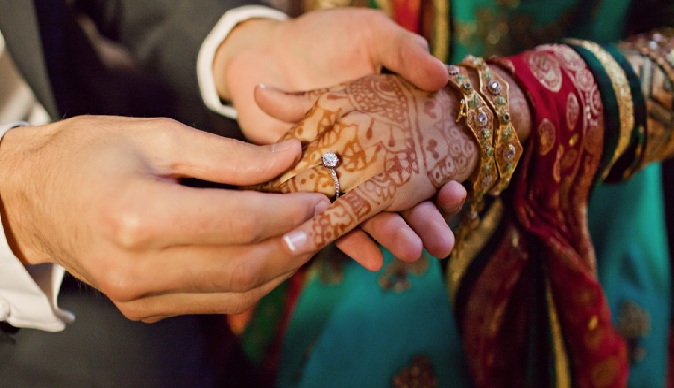
1. Sankalpa, Poonyahvachanam and Ganesha Puja
2. Request by the Groom's father for the bride's hand for his son. Bride's father's approval.
3. Bride's father and his daughter propose the marriage at the appropriate Muhurtam.
4. Groom's father and his son reconfirm the proposal.
5. Bride worships Shachi for the success of the future marriage.
6. Mangal Aarati of the bride by 5 women
7. Bride and the Groom exchange the rings.
8. Formal engagement Announcement, Ashirvad, Congratulations.
GRAHA SHANTI

The Graha Shanti is typically done a day before the formal marriage ceremony so that maximum number of outside guests can attend the function.
The primary purpose of the pre wedding rituals is to kick off the religious and social festivities leading to the marriage ceremony.
These rituals are known by various names such as Devak, Grahamak, Graha Shanti etc.
These rituals are typically done separately by the boy's and girl's parents in their own homes.
However, they can also be done together, if necessary.
It takes about an hour to set up and one hour to do these rituals.
Graha Shanti Puja is done to appease the particular planet which is an adverse position in one's horoscope or to enhance the effect of a positive influence of a particular planet.
Each planetary power has to be appeased in a different way and thus the Puja ritual.
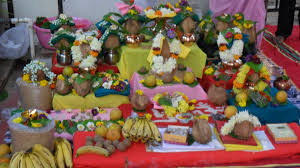
Surya Puja is to appease the planetary power Sun, the supreme power of the solar system.
Surya Puja is indicated when Sun is powerless or depleted in the horoscope.
Chandra Puja is performed to appease the planetary power of the Moon, the Second Supreme power in astrology,the Queen.
Moon is the planet, which rules our emotions, our thoughts and fortune, fame, memory, success, happiness, and comforts.
Mangal Puja is performed to appease planet Mars. Mars is the 'Prince' among all the planets.
Performing Mangal Puja can reduce the troubles and hurdles caused due to malefic position of Mars in the horoscope.
Budh Puja is peformed to appease planet Mercury.
Budh Puja enhances the power of speech and is recommended to reduce the tribulations caused due to malefic position of Mercury in the horoscope.
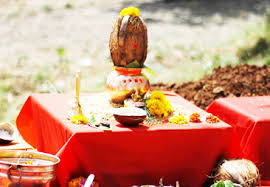
Brihaspati Puja is perform to appease planet Jupiter.
Jupiter is the largest planet in the solar system. According to Hindu Shastra, "Brahaspati" is known as "Guru" or teacher of all "Devtas".
Jupiter Puja is very auspicious planet and Puja in honour of Jupiter enhances wisdom, knowledge, religion, fortune, happiness, welfare, joy, devotion, spirituality, generosity, charity, gentleness, statesmanship, fame, wealth , respect, reputation, honor, dignity and social status.
If Jupiter is well placed in the horoscope one can enjoy all the joys of life. Yet, one can find his life ruined in all respects due to malefic effects of planet Jupiter. Brihaspati Puja is recommended to increase the power of the benefic Jupiter or to reduce the tribulations caused by malefic Jupiter.
Shukra Puja is performed to appease planet Venus, the Guru of demons, Venus is the most shining and beautiful planet in the solar system.
Shukra Puja is recommended to remove the malefic effects of Venus in one's horoscope.
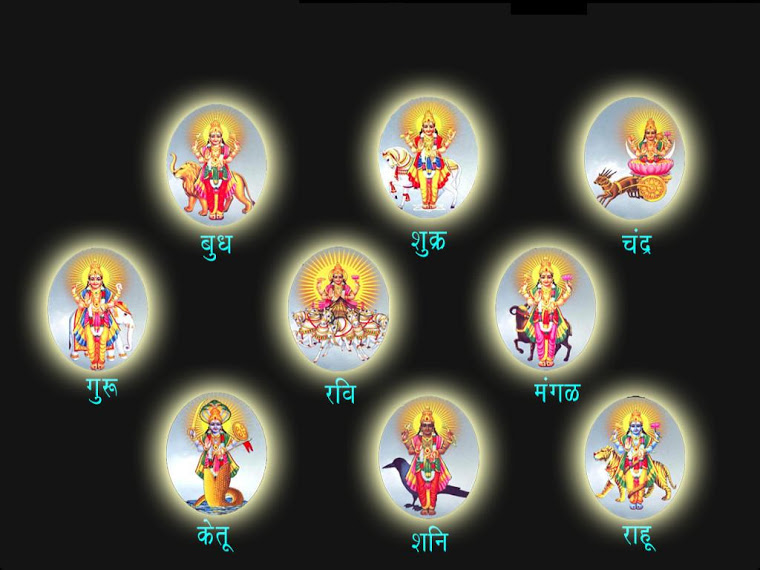
Shani Puja is performed to appease planet planet Saturn, Saturn is the slowest planet in the solar system.
If Saturn is malefic in one horoscope chart then Shani Puja is recommend to remove the malefic effects.
Rahu Puja is performed to appease the planetary power Rahu, the dragon's head.
Rahu is said to be a shadow planet. When the Dragon's Head is malefic in one horoscope chart then Rahu Puja is recommended to remove the malefic effects.
Ketu Puja is performed to appease planetary power Ketu, the dragon's tail. Ketu is also said to be a shadow planet.
If Dragon's Tail is malefic in one horoscope chart then Ketu Puja is recommend to remove the malefic effects.
Wedding Ceremony

In Hindu culture, marriage is one of the most important sanskaras or rites of passage that a Hindu observes during his or her lifetime.
Briefly stated, the marriage or the Vivaah Sanskar is the transition from the first stage of life, devoted to education and learning, to the second stage of life, devoted to building a household and raising children.
The married couple pursues Dharma, performing the righteous duty, Artha, the acquisition of wealth and Kama, the enjoyment of natural desires.
They lead a productive life of work, service and enjoyment, fulfilling various duties and obligations towards themselves, their families and society at large.
In Hindu scripture, marriage is a sacrament with strong moral and ethical values.
It is meant to unite the bride and the groom firmly so that they essentially become one in soul and spirit.
The Hindu marriage ceremony is primarily based on the marriage of Surya, the daughter of Savita (The Sun) to Ashwinikumar, as described in the Rig-Veda, one of the oldest Hindu scriptures.
After Ashwinikumar wins the chariot race, Savita gives away the bride in a splendid ceremony. It is written in Sanskrit, one of the oldest language in the world.
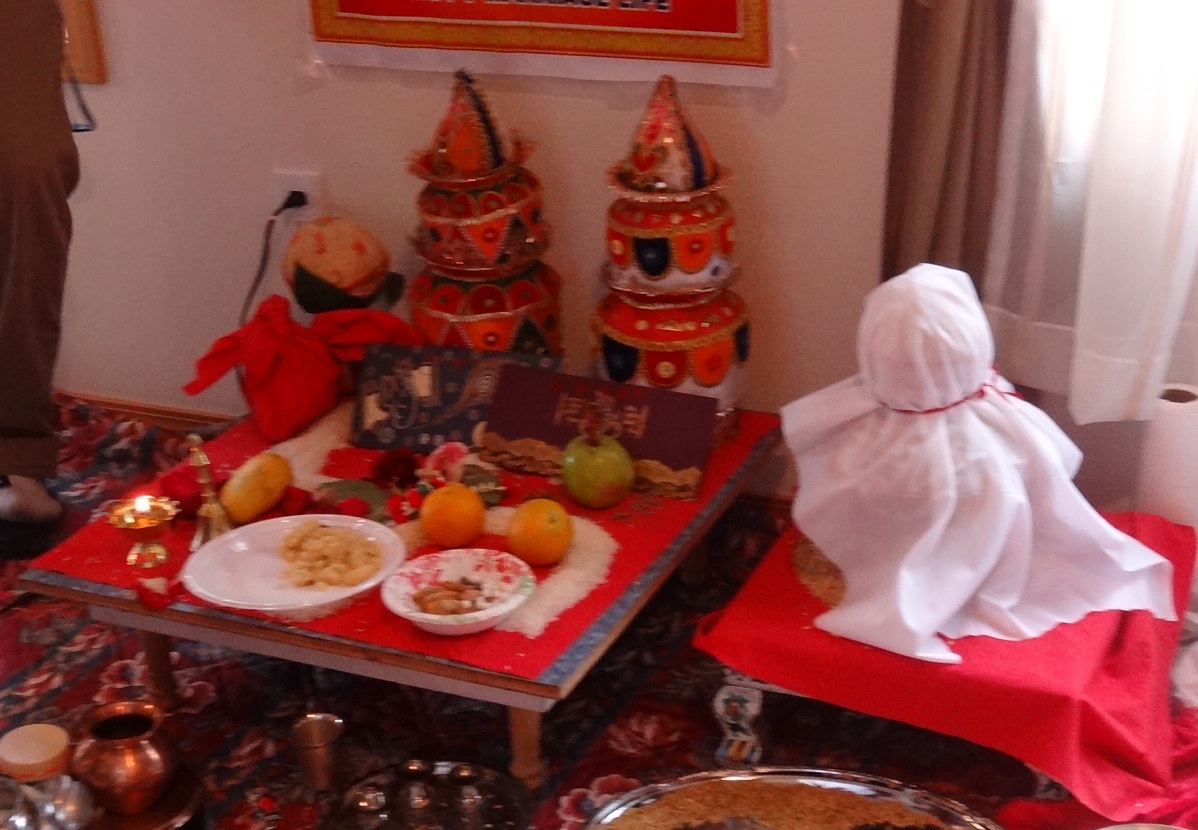
Think of the actual wedding ceremony as if it were a romantic story, where the bride and the groom come to the Mandap, separately, as if unknown to each other.
Then they fall in love and ask the parents' permission to get married. We explain them what the Hindu marriage means and they accept the obligations that go with it.
During the various rituals, the couple commits to remain faithful to each other and repeat the pledge in front of the Fire God, the Agni and all the witnesses.
Then, they walk seven steps together committing to seven marriage vows to each other, about their future life together.
We all bless them and wish them a very happy life and they leave the Mandap as a newly married couple!
The traditional hosts for the ceremony are the bride's parents.
The groom and his family are the guests arriving from outside to the Mandap.
The ceremony revolves around the bride and her transition to the in law's home.
The ceremony depicts the transition for the Bride and the Groom, from the first stage of their lives, Brahmacharyashram, to the second stage of their lives, Grahasthashram.
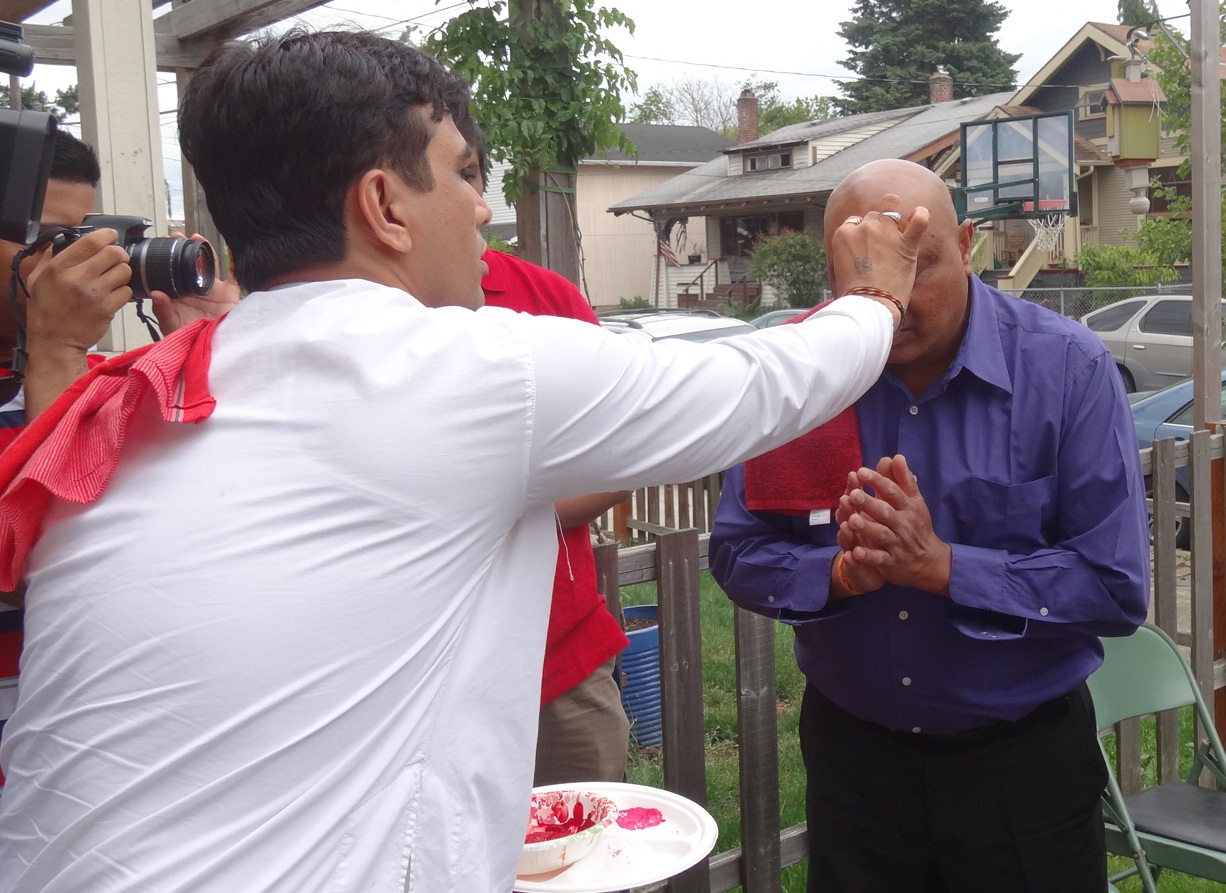 It takes you thru the logical steps of first meeting of the bride and the groom, their decision to get married,
bride's parents giving away the bride, the couple committing to marriage in front of the sacred fire,
bride's transition to her in-law's home, the couple taking the seven vows and the friends and families blessing the newly wedded couple.
It takes you thru the logical steps of first meeting of the bride and the groom, their decision to get married,
bride's parents giving away the bride, the couple committing to marriage in front of the sacred fire,
bride's transition to her in-law's home, the couple taking the seven vows and the friends and families blessing the newly wedded couple.
Following are the essential steps of the ceremony.
They will be customized to each specific wedding and the overall program will be distributed at the ceremony.
Swagatam Madhuperk- Welcoming Groom & his family
The Barat, the singing and dancing procession of the groom and his family, reaches the wedding venue.
The bride's family welcomes them with Aarati and sweets, as a symbol of happiness and good tidings to come and escort them to the wedding hall.

Shri Ganesh Prayers & Poonyahvachanam
After all are seated, we start the ceremony with prayers to Lord Ganesh to bless this occasion and make the marriage ceremony free of obstacles.
We solicit the blessings of elders and our forefathers, and pray for this to be an auspicious day for the marriage ceremony.
Vadhu Aagman - Arrival of the Bride
Bride is brought to the mandap typically by her maternal uncle, along with bridesmaids, and grooms'men.
An antarpat, an auspicious cloth, separates Bride and Groom as a symbol of their separate existence prior to the marriage.
Mangalashtakam & Sankalpa - Mutual Approval
After the Mangalmantras are recited, Bride and Groom garland each other, indicating their mutual approval to proceed with the ceremony.
The Pandit explains them the objectives of the Vivaah Samskar and then they propose to marry each other and enter the Grahasthashrama as a married couple.
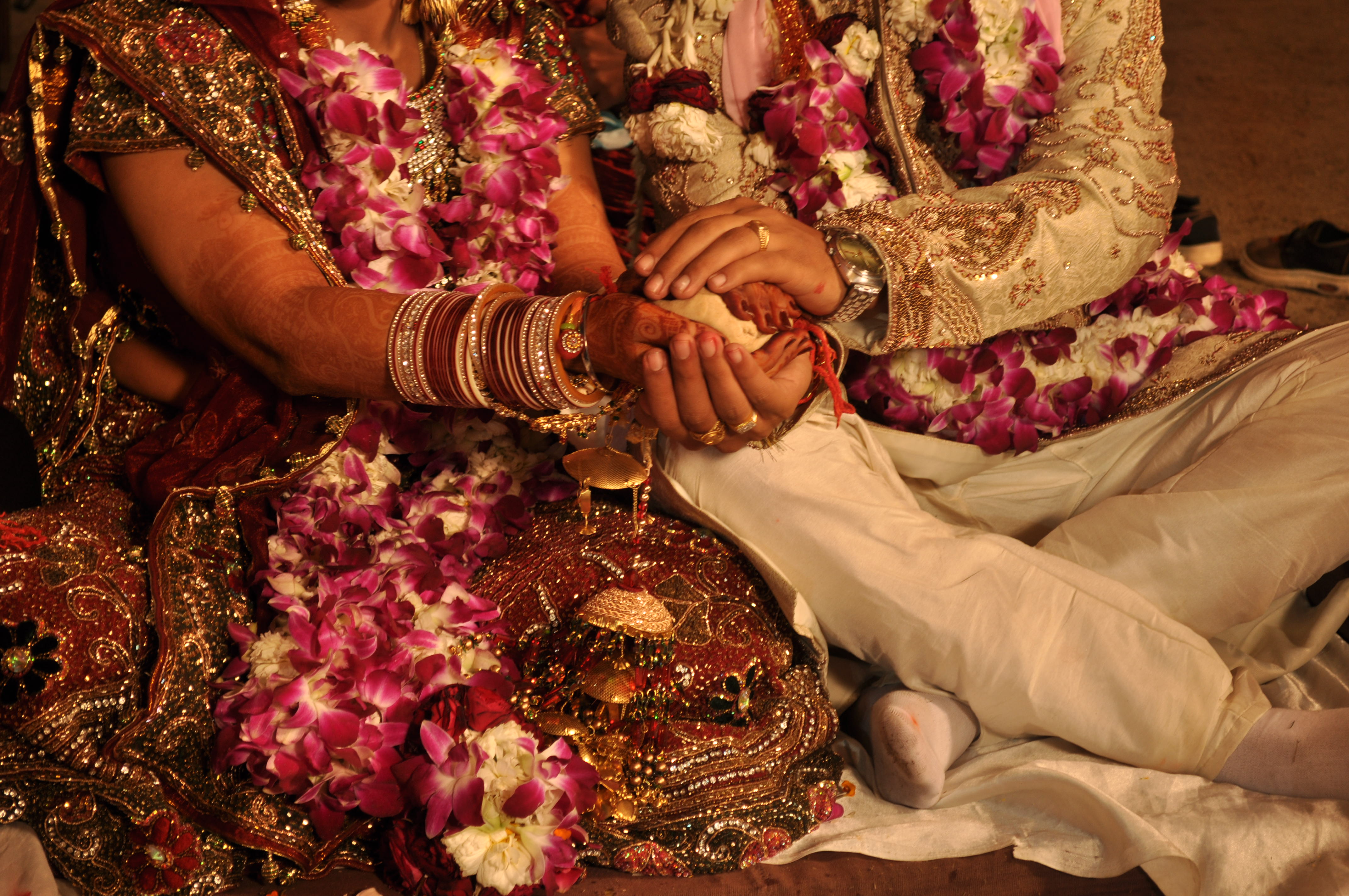
Kannyadaan - Giving Away the Bride
In the Brahma Vivaah, the highest form of Hindu marriage, Bride's parents, "give away" the Bride as one of the noblest acts they will perform in their lifetime.
Bride and Groom then commit to remain faithful to each other, while pursuing Dharma, Artha and Kama.
Bride's mother pours holy water on bride's father's palms, which flows into Groom's and then into Bride's palms,
symbolizing the continuity of life, repaying the debt to their forefathers and the passing of the family heritage to the next generation.
Akshatropanam & Panigrahanam (Hastmelap) - Expectations from Married Life
The Bride and the Groom communicate their expectations of married life and show their consent by showering rice on each other.
Bride requests his support for a healthy and prosperous family life. Groom requests her support in pursuing Dharma and for her cooperation in his various endeavors for a successful life.
They accept each other's hands with blessings of Heavenly Gods with a promise to stay together for the rest of their lives, symbolically tying each other's wrists with sacred thread which is called Sutrabandhanam.
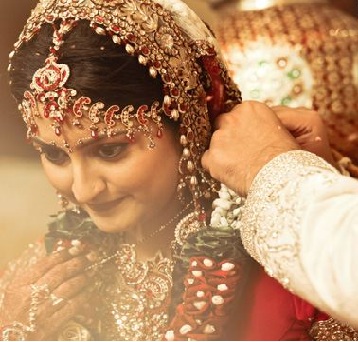
Mangalsutrabandhanam - Marriage Commitment to Each Other
Groom adorns Bride's neck with the Mangalsutra, a necklace symbolizing good luck, love and friendship. Groom applies kumkum on Bride's forehead, now as a Soubhagyavati.
Bride applies chandan tilak on Groom's forehead, now as a Grahastha. With the wedding ring exchange, they commit to support each other, in good times and bad times, in happiness and sorrow, with unending love.
They are joined together in a marriage knot by the Groom's sister or mother, as a symbol of their permanent bond
Vivaah Homa - Worshipping the Sacred Fire
Vivaah Homa is the start of the Grahasthashrama for the couple. The couple lights the Agni, the holy fire that symbolizes light, power and knowledge, and acts as a witness to the ceremony.
Bride and Groom repeat the sacred pledge of marriage and request Agni to be the messenger for their prayers to various Gods, for Santati (children), Sampatti (wealth & prosperity) and Deergharogya (long & healthy lives).
Laja Homa & Agni Pradakshina - Starting the Marriage Journey
They circle the sacred fire four times, starting their transition into married life, supported by Bride's brother, as her lifelong supporter. As they circle the fire, Groom poetically describes to Bride their complementary relationship.
I am the sky, you are the earth. I am the thought, you are the speech. I am the fire and you are the fuel. I am the song, you are the verse;I am the ocean, you are the shore.
I am the strength but you are the beauty. I am the Purush, and you are my Prakriti.
Let us live together lovingly & bring up our progeny. Let us lead a joyful life of a hundred years. Please ascend this stone and be as firm throughout our married life.
After the Agni Pradakshina, the Bride moves to the left side of the Groom; indicating her transition to the Groom's family.
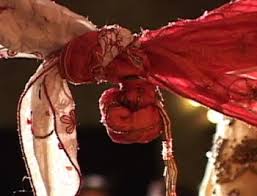
Saptapadi - Taking the Marriage Vows with Seven Steps
The couple takes seven steps together to reiterate their aspirations of their married life.
1. With the first step, we will provide for and support each other.
2. With the second step, we will develop mental, physical & spiritual strength.
3. With the third step, we will share the worldly possessions.
4. With the fourth step, we will acquire knowledge, happiness and peace.
5. With the fifth step, we will raise strong and virtuous children.
6. With the sixth step, we will enjoy the fruits of all seasons.
7. With the seventh step, we will always remain friends and cherish each other.
Ashirvad - Blessings
We all offer our blessings to the couple for long and happy lives together. After being declared as Husband and Wife, Groom and Bride bow to all invited guests and leave the mandap as a newly married couple as the guests shower them with flower petals.
If you have any question send me an email : portlandpandit@gmail.com OR info@portlandpandit.com OR write a message
Grih Pravesh (Vastu Shanti)

The house we live in is not an object made of brick and mortar but an entity with the "grih purush" or the spirit of the house dwelling in it.
A house becomes a home when the residents of the house quell the spirits, purify the environment by reverberation of the mantras and the smoke emanating from the hawan.
All the planetary deities are also pacified by Puja.
The owner of the house and his family all sit together on an auspicious day and perform the devata Puja.
Grah shanti Puja and the hawan to make the house habitable.
This ritual is believed to ward off any bad spirits, negative energy that may be present in the house and bring peace, prosperity and good health for the inhabitants.
Thus, the "grih pravesh" is an important ritual that one should perform before one enters a new home.
This ritual is an extension of "vaastu shashtra", a science that tells us the best way to build a house and the optimizes the use of spaces that are used as residences, offices or factories.

Vastu Shanti:
Vastu Shanti is a part of Sthapatya Veda (vedic architecture).
According to the Vaastu shastra, energy imbalances in the home are the cause of obstacles in one's progress.
Sometimes there are faults in construction to add to any innate problems with the present energy of the environment.
This Yagya is highly recommended when moving into a new home.
It removes all evil and negativity of the home, improves the health of the residents, increase creativity & inner intelligence, increase the longivity of life, growth in spiritual & material life, increase harmony & stability in family.
In commercial place by performing Vastu yagya improves the efficiency of employees, expansion & profit in business.
The process involves energizing the actual ground or bhoomi, the foundations, the central pillars and the entrances of the house.
It is also highly beneficial if some one is not living in a house according to vastu.
It corrects the Vastu dosha when performed periodically.
This is done before ground breaking. After purchasing the land the person have to contact their astrologer to take the muhurta for ground breaking .
Then on the basis of that muhurta Panditji will do Puja and Yagya.

Griha Pravesh Yagya:
It is done after completing the house and on this day special Yagya very briefly will take place and the house owner with family will enter in that home.
This Yagya is for pacification of all negative energy and increasing more harmony, wellbeing and overall progress in that home.
Many things have to followed during the time of construction.
Panditji will guide if some one needs his service.
So importantly for having a good house according to Sthapatya Veda is, choosing a proper land, starting every thing with proper muhurta and Yagya, construction as per the vedic rules and performing Vastu Yagya before entering the home first time.
Ganesha Puja
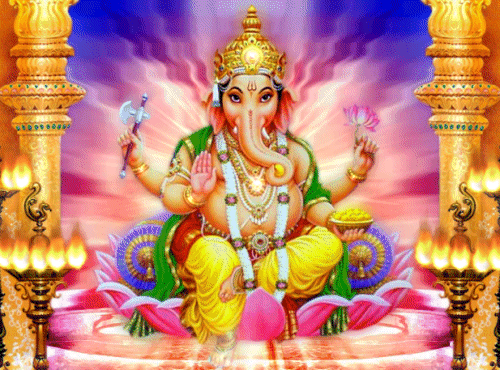
As per Hindu belief, Lord Ganesha is one of the most important deities and in every puja people perform Ganesh Puja.
We see in many occasions that before beginning any new or good work they worship or offer prayers to Lord Ganesha.
Even the festival like Vastu puja, Durga Puja begins with the formal ritual offered to the Ganesha.
Ganesh Puja holds very much importance on the day of this festive occasion and it is a belief that by offering prayers to the deity, one can easily get rid of all troubles and become prosperous.
During the puja people also make offerings of abeer, gulal, saffron paste, sandal paste garland of cotton beads and more as per the wish of a particular person.
All this really enhances the atmosphere of the home especially the place of puja.
This is of much significance during the all kindg of celebration.
All over the country as it is the bringer of positive energy.
Satyanarayan Katha

Satyanarayana Puja: In kali Yuga, people lead mechanical life in search of happiness and not able to perform japa, homa, puja etc in the pretext of lack of time.
Hence the God almighty himself has provided a solution namely satyanarayana vratanusthana a simplest way to seek blessings of the lord.
Satyanarayana puja/ vratanusthana is narrated in Skandapurana. The puja is generally performed in the evenings of full moon day or Ekadasi or any other auspicious day in connection with marriage/house warming/fulfillment of desire etc.
Satyanarayana puja is performed in reverence to the lord Satyanarayana form of lord Mahavishnu. The Lord in this form is considered to be the embodiment of the truth.
This is a Hindu religious observance. It is a ritual performed by Hindus before or on any major occasion like marriage, house warming ceremony etc., It is believed that this Puja originated in Bengal as Satya Pir and all communities perform it for their family welfare.
1. Satyanarayan Puja is one of the best & easiest ways to seek blessings from Lord Vishnu, who is the God responsible for maintenance of this Universe.
2. Typically Satyanarayan Puja is to be performed before and/or after the fulfillment of our desires e.g. if you want to achieve some important milestones in your life like success in Higher Education, Success in career, promotion, buying a new vehicle, new house, starting a new business, negotiating big professional deals etc...
3. Satyanarayan is also useful if someone in the family is not well.
4. In order to maintain general happiness, prosperity and well being of the family it is advisable to perform Satyanarayan Puja at least once every year.
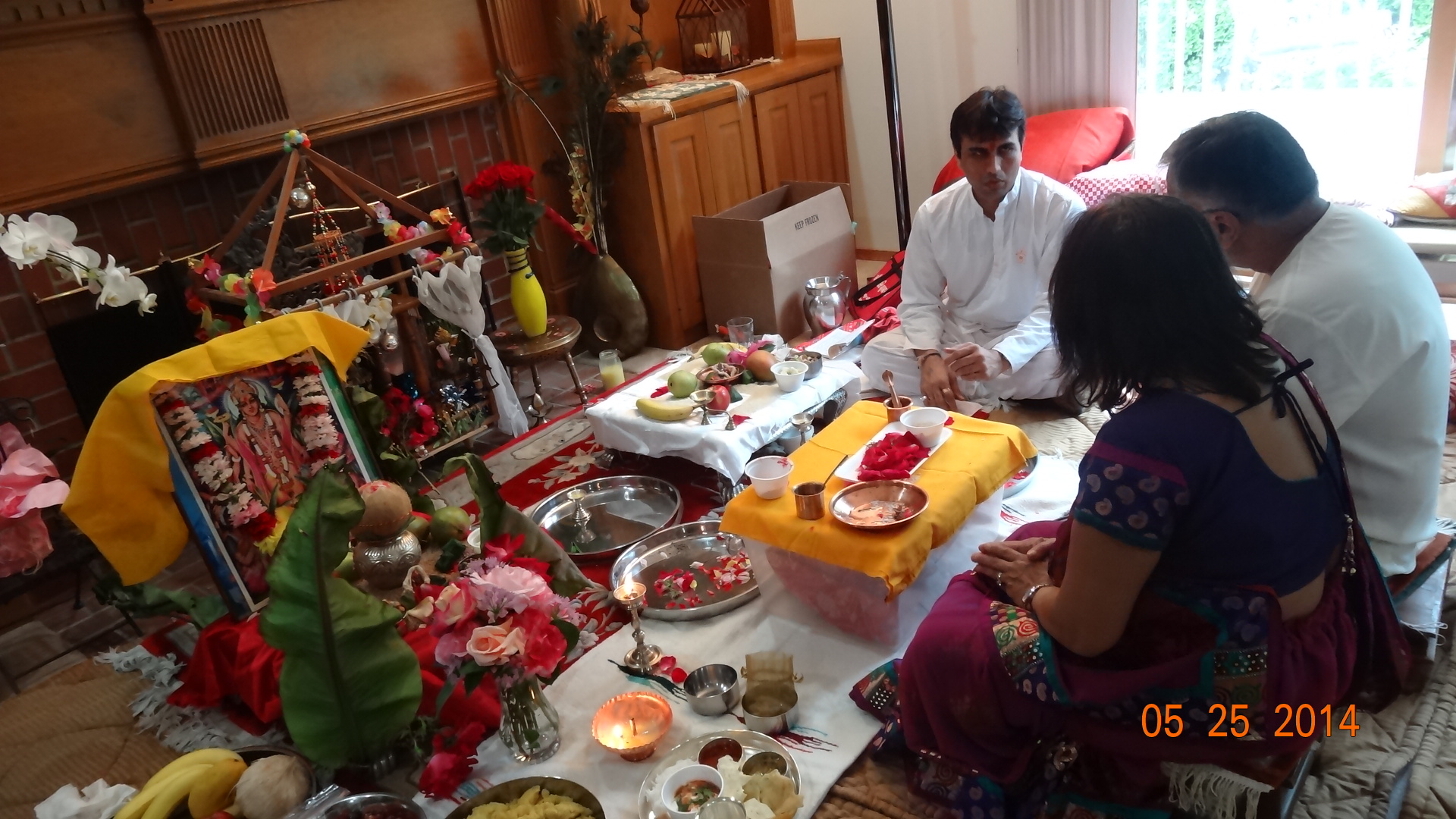 5. There is no hard and fast rule as to when Satyanarayan Puja to be performed. Morning or evening time is ideal for Puja. You can perform it after major achievements in life. So also it is ideal to perform Satyanarayan Puja once every year. It is a great auspicious occasions to invite friends and relatives.
5. There is no hard and fast rule as to when Satyanarayan Puja to be performed. Morning or evening time is ideal for Puja. You can perform it after major achievements in life. So also it is ideal to perform Satyanarayan Puja once every year. It is a great auspicious occasions to invite friends and relatives.
6. It is a custom to have some program of singing, dancing, playing musical instruments etc... with well wisher friends and relatives after the Puja is over.
7. Satyanarayan Puja is to be performed on an auspicious day in consultation with Panditji.
8. Satyanarayan is about 3.5 to 4 hours Puja
If you have any question send me an email : portlandpandit@gmail.com OR info@portlandpandit.com OR write a message
Godh Bharai/Shrimantam (Baby Showers)

The Punsvan Sanskar (Baby Showers) Performed during the period of pregnancy, invoking blessings for Divine protection for his/her bright future.
Generally performed Ganesha Puja with chanting of mantras during a Puja strengthens health development of the gross (physical), subtle (mental) and astral (conscious) body of the child.
Godh Bharai is a ceremony that hold utmost spiritual significance in India with different lingual communities having their own name for this Hindu ritual.In Northern India, it is called Godh Bharai, in the East it is called 'Shaad' and in the South it is called Shrimantam.
Traditionally, the godh bharai ceremony begins by having the mother-to-be decked up like a bride.
She is then made to sit in a place of honor. Then the mother-to-be holds out her 'palla' or the draped part of her saree.
All the guests bless the pregnant lady and put their gifts in her 'godh' or lap. This is where this pregnancy ritual gets it name from.
The mother-to-be is also fed delicious foods during the ceremony usually prepared by her mother or mother-in-law.
In fact, all her favorite dishes are prepared for the godh bharai ceremony. Every woman who are part of the godh bharai function whisper into the pregnant lady's ears and say something good about her baby.

The relatives and family members make all kinds of effort to keep the mom-to-be happy and stay smiling always.
They receive advices, suggestions and many gifts on this occasion that helps the parents-to-be to get prepared for the arrival of the child.
The ceremony is concluded by singing and dancing to celebrate the coming of a new member in the family.
This Hindu ritual is carried out during the 7th month of pregnancy.
This means that the child is now in a safe. The lap of the mother-to-be is filled with fruits and gifts and blessings from elders.
However, the time period varies among different communities. Sometimes, this ritual can also be done in the 8th or 9th month of pregnancy.
The expected mom wears new clothes and her hands are filled with henna designs.
Many elders give useful suggestions as the mother is going to enter a new and very important phase of her life after this.
The tradition and the way of performing Godh Bharai may differ from one place, state or family to another but the process remains more or less the same.
The expecting women takes blessings from God and then from elders and is offered various gifts and presents that are usually for the mom or the child.
The basic purpose of a godh bharai ceremony is to give the mother-to-be lots of love and gifts for herself and her baby.
Godh bharai is usually an all-women function. Men are not allowed in this ceremony.
It is the women of the family who have a gala time centered around the mom-to-be.

Traditionally men did not attend baby shower ceremonies as well but in today's cosmopolitan environment, they are not left out.
Godh bharai is a religious ceremony and not just a gathering of friends like a baby shower.
Godh bharai is done on an auspicious date selected by the priests.
In some communities a puja is also performed during this ceremony.
Apart from being given many generous gifts, the mother-to-be is fed a lot of delicious foods during this ceremony.
Like all other Hindu rituals, godh bharai is also an excuse to bring together family and friends to foster a feeling of community.
Indians consider any addition to their family as a blessing of God and so celebrate all such occasions with great enthusiasm.
Namkaran Sanskar (Namin ceremony)

A naming ceremony is the event at which an infant, a youth, or an adult is given a name or names. The timing can vary from mere days after birth to several months or many years afterwards. Some of these ceremonies have religious or cultural significance.
The ceremony of naming the child - A sacrament for imposing of divinity in newly-born human child.
The Namkaran Sanskar (Naming Ceremony) of the child is normally performed on the tenth day after birth, but can be performed within a month or whenever name is given to child.
It is also a sacrament for imposition of divinity in a newly born child.
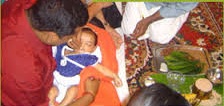 During this ceremony, the importance and education is given to parent and other family members that the child should be given the atmosphere where his/her inherent qualities can be awakened and undesirable traces of previous birth can be uprooted.
The child should be named in a manner that is meaningful and reflects a noble quality.
During Namkaran sanskar parents are encouraged that child is also for society & should be encouraged to be friendly with other family members, neighbor & whole world.
During this ceremony, the importance and education is given to parent and other family members that the child should be given the atmosphere where his/her inherent qualities can be awakened and undesirable traces of previous birth can be uprooted.
The child should be named in a manner that is meaningful and reflects a noble quality.
During Namkaran sanskar parents are encouraged that child is also for society & should be encouraged to be friendly with other family members, neighbor & whole world.
Mundan Sanskar (Tonsure ceremony)

The Mundan Sanskar (tonsure ceremony) of children - Eradication of beastly tendencies & sowing seeds.
It is performed at the age between 1 to 5 years regardless of gender.
Nowhere in our scriptures are mentioned the differences between a girl and a boy.
In fact, the Vedas say, " Dash putra sama yasya shilvati soota ", meaning a moral girl is equivalent of ten boys.
It aims at eradication of beastly tendencies and sowing seeds of cultural consciousness in the child.
It is also performed for harmonious titillation of the nerves and proper development of the brain.

It is said that birth hair carries undesirable ideas and traits from past birth.
So they need to be removed and new ideas full of eminence should be grown in its place.
Parents are given education that the success of life is in using our talents, capabilities, and intelligence to benefit the world.
Please speak to one of us for performing Mundan Sanskar .
Yagyopaveet Sanskar

The sacred thread ceremony - Installation of the principles of Indian culture - taking pledge to lead disciplines, dignified spiritual life.
The most important sanskar for teenagers and youth , regardless of gender. It indeed gives "new birth" ( dwijatva ) to a person.
The development of personality coherent with the dignity of human-being begins only after one adopts certain moral values and disciplines of humanity and enlightens his/her mind as well as inner self.
The Yagyopaveet sanskar is performed to channelize this development . The initiation of the Gayatri Mantra and experiments of spiritual elevation is associated with this sanskar .
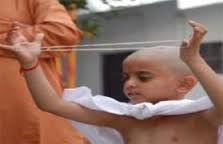
If you have any question send me an email : portlandpandit@gmail.com OR info@portlandpandit.com OR write a message
Antyeshti Sanskaar (Antim Sanskar)
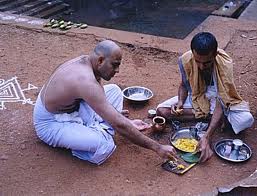
Antyesti or Hindu funeral rites, also referred to as Antim Sanskar, is an important Sanskara, sacrament of Hindu society.
Extensive texts of such rites are available, particularly in the Garuda Purana. There is wide inconsistency in theory and practice, and the procedures differ from place to place.
The Antyeshti Sanskaar is the last of the most important 16 sanskaars described in our scriptures.
The term "Sanskaar" is often interpreted to mean "rights of passage".
This description aptly fits the Antyeshti Sanskaar more than any of the others.
Death, to the Hindu, is merely the end of one phase of a long journey - for some - to God realization.
The journey of the Atma embodied in a subtle form continues in the hereafter with the advent of death.
This journey is described as being, for the sinner, a torturous one, beset with many difficulties, dangers, trials and tribulations.
It is with a view to making this passage into the hereafter as easy and as simple as possible that the Hindu performs the Antyeshti Sanskaar for his beloved ones with great faith, love and devotion (shradhaa), so that the atma of that individual will attain a good state (sadgati) in the hereafter.
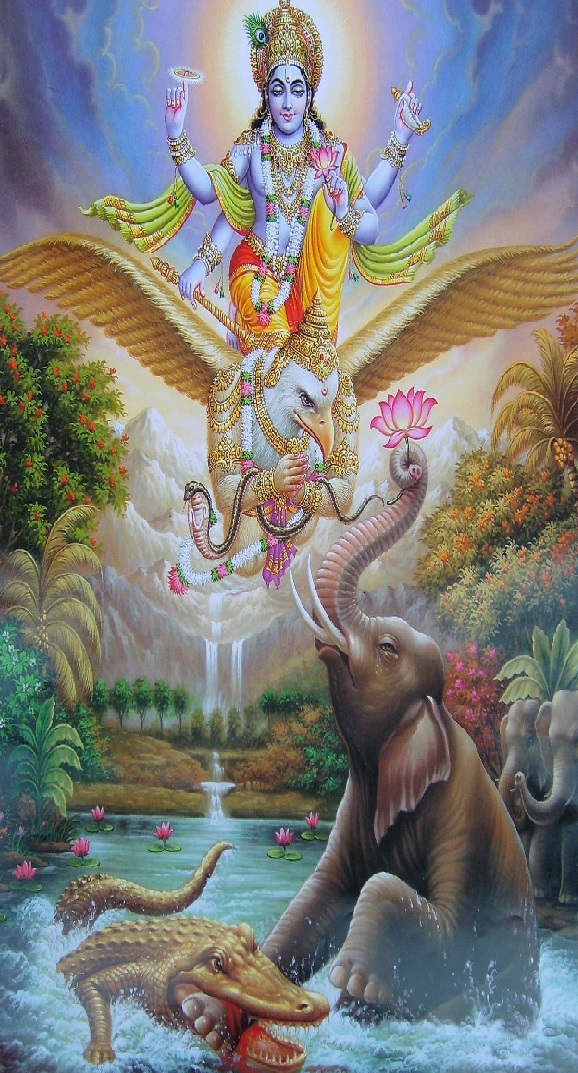
शुक्लांबरधरं विष्णुं शशि वर्णं चतुर्भुजं ।
प्रसन्न वदनं ध्यायेत सर्व विघ्नोपशान्तये॥
Gajendra Moksha गजेन्द्रमोक्षः or The Liberation of Gajendra is Puranic legend from the 8th Skandha of Bhagavad Purana, one of the most sacred books in Hinduism.
It is one of the famous exploits of Lord Vishnu. In this moving episode Lord Vishnu came down to earth to protect Gajendra, the Elephant from the clutches of Makara, the Crocodile and awards him moksha or salvation.
Gajendra is then said to have attained the similar four-armed form (Sarupya Mukti) of God and goes to Vaikuntha with Lord Vishnu.
Download Gajendra Moksha Gujarati PDF
Listen Gajendra Moksha Gujarati (Thanks to my Mom who sang this Gajendra Moksha Path)
here was once an elephant named Gajendra who used to live in a garden called Rtumata which was created by Varuna. This garden was situated in the beautiful mountains of Trikuta in ancient India. Gajendra ruled over all the other elephants in the herd. On a hot day, he proceeded with his herd to a lake to cool off in its fresh waters. Suddenly a crocodile living in the lake attacked Gajendra and caught him by the leg. Gajendra tried for a long time to escape from the crocodile's clutches. All his family, relatives and friends gathered around to help him, but in vain. The crocodile wouldn't simply let go. When they realised that ‘death’ has come close to Gajendra, they left him alone. He trumpeted in pain and helplessness until he was hoarse. As the struggle was seemingly endless and when the last drop of energy was also sapped, Gajendra called to god Vishnu to save him, holding a lotus up in the air as an offering. It is believed that Gajendra's foot was held by the crocodile for over a thousand of years.
Hearing his devotee's call and a prayer, Lord Vishnu rushed to the scene. As Gajendra sighted the Lord coming, he lifted a lotus with his trunk, seeing this lord was pleased and with his Sudharshana Chakra separated the crocodile's head from its body and Gajendra prostrated before the Lord. Vishnu informed Gajendra that he, in one of his previous births, was the celebrated King Indradyumna, a Vishnu devotee, but due to his disrespect to the great Sage Agastya, he was cursed and had to undergo this life.
Because Indradyumna was a chosen one, Lord Vishnu had him born as Gajendra and made him realize that there is something called, "Kaivalya" which is beyond Svarga and Urdhva Loka. Indradyumna could attain Moksha finally when he (as Gajendra) left all his pride and doubt and totally surrendered himself to Vishnu.
The prayer made by Gajendra on this occasion became a famous hymn in praise of Vishnu called the Gajendra Stuti.
it is believed that this incident has happened in Sonepur. There is a Temple Devoted to Lord Vishnu known as "Hariharnath Mandir" at the banks of Gandaki River.
Sonepur hosts one of the world's largest cattle fairs in Asia which starts on Karthik Poornima. Sonepur also has the confluence of four rivers.
Garuda Purana
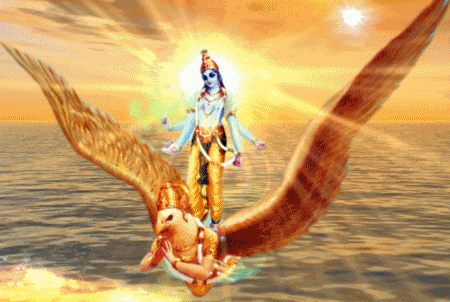
Garuda Purana (Devanagari गरुड़ पुराण) is one of the eighteen Puranas which are part of the Hindu body of texts known as smriti.
It is a Vaishnava Purana and the epic is in form of conversation between Lord Vishnu and Garuda (King of Birds), primarily emphasizing the reason and meaning of Human Life form.
Chapter 1 : Methods to create Body of dead person to travel to Bio Chip Master
Chapter 2 : Methods to feed Atman after death
Chapter 3 : De Coding of Bio Chip and reading information of Bio Creations Chapter 1-2-3
Chapter 4 : Actions for hell
Chapter 5 : Birth as per past actions
Chapter 6 : Life during pregnancy Chapter 4,5,6
Chapter 7 : Benefit of Male children
Chapter 8 : Donation at death time and it's benefits
Chapter 9 : Methods to provide food for dead person Chapter 7,8,9
Chapter 10 : Panchak and methods to avoid bad effect of Panchak
Chapter 11 : Creation of Body of a dead person
Chapter 12 : Donations on eleventh day celebrations Chapter 10,11,12
Chapter 13 : Death on Bed and it's effects
Chapter 14 : Four doors of Bio Chip Master
Chapter 15 ; After suffering or enjoying hell or heaven one takes rebirth Chapter 13,14,15
Chapter 16 : Benefit of birth as human being
Chapter 17 : Benefits to listen Garuda Puran Chapter 16,17
Listen Garuda Purana Online
Pind Dann Pujan
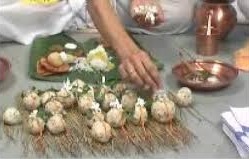
Pind Dann
Pujan
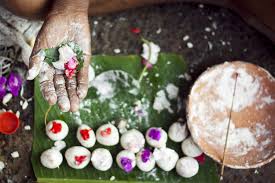
Pitru Trapan
Pujan
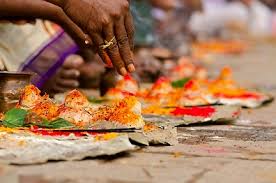
Shradha
Pujan
Life and Death
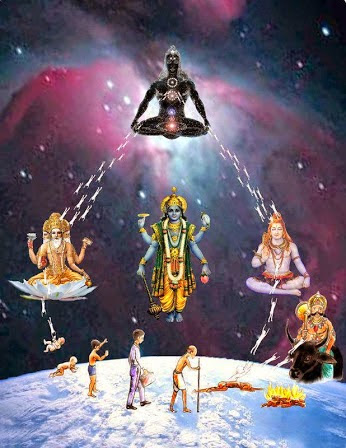
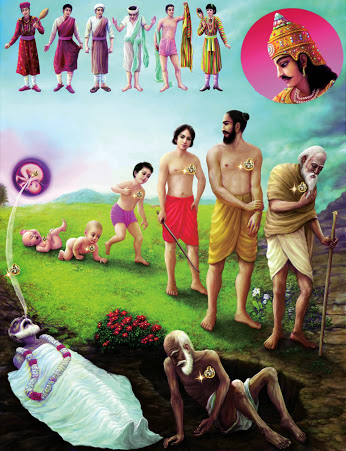
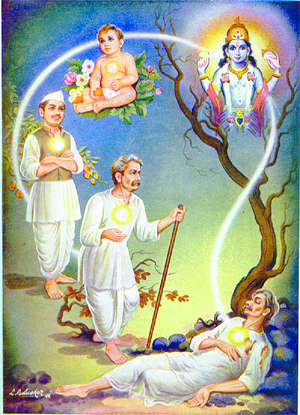
If you have any question send me an email : portlandpandit@gmail.com OR info@portlandpandit.com OR write a message
Janak Bhai performed our new house blessing (Vaastu Shanti) and Satyanarayan Katha, and we were absolutely impressed with his performance and knowledge of the rituals. He comes extremely prepared, and possesses a very likeable personality, and his delivery style keeps everyone engaged. Our family was very impressed with him.
Thank you Janak Bhai for doing our vaastu puja. We all enjoyed the puja very much and hope you can make it out to Washington again for another puja.
Janak performed Satyanarayan pooja at my house. I really liked the way the entire pooja was performed. He is very knowledgeable and very experienced in pooja. I highly recommend him. He can perform pooja in different languages to cover the entire audience. He is well prepared and will guide you properly.
If you are looking for a Pandit, your search stops with Janakbhai. We had a great experience with him when he performed Satyanarayan Puja at our place recently. He has a very amicable personality which makes the whole experience highly pleasurable. Professionally speaking, he was punctual (reached at 6 am as decided) and knowledgeable (eg narrated the katha very well). His decoration was excellent and guided the puja elaborately and patiently. I highly recommend Janakbhai for his excellence as a Pandit.
Engagement Ceremony

1. Sankalpa, Poonyahvachanam and Ganesha Puja
2. Request by the Groom's father for the bride's hand for his son. Bride's father's approval.
3. Bride's father and his daughter propose the marriage at the appropriate Muhurtam.
4. Groom's father and his son reconfirm the proposal.
5. Bride worships Shachi for the success of the future marriage.
6. Mangal Aarati of the bride by 5 women
7. Bride and the Groom exchange the rings.
8. Formal engagement Announcement, Ashirvad, Congratulations.
GRAHA SHANTI

The Graha Shanti is typically done a day before the formal marriage ceremony so that maximum number of outside guests can attend the function. The primary purpose of the pre wedding rituals is to kick off the religious and social festivities leading to the marriage ceremony. These rituals are known by various names such as Devak, Grahamak, Graha Shanti etc. These rituals are typically done separately by the boy's and girl's parents in their own homes. However, they can also be done together, if necessary. It takes about an hour to set up and one hour to do these rituals.
Graha Shanti Puja is done to appease the particular planet which is an adverse position in one's horoscope or to enhance the effect of a positive influence of a particular planet. Each planetary power has to be appeased in a different way and thus the Puja ritual.

Surya Puja is to appease the planetary power Sun, the supreme power of the solar system. Surya Puja is indicated when Sun is powerless or depleted in the horoscope.
Chandra Puja is performed to appease the planetary power of the Moon, the Second Supreme power in astrology,the Queen. Moon is the planet, which rules our emotions, our thoughts and fortune, fame, memory, success, happiness, and comforts.
Mangal Puja is performed to appease planet Mars. Mars is the 'Prince' among all the planets. Performing Mangal Puja can reduce the troubles and hurdles caused due to malefic position of Mars in the horoscope.
Budh Puja is peformed to appease planet Mercury. Budh Puja enhances the power of speech and is recommended to reduce the tribulations caused due to malefic position of Mercury in the horoscope.

Brihaspati Puja is perform to appease planet Jupiter. Jupiter is the largest planet in the solar system. According to Hindu Shastra, "Brahaspati" is known as "Guru" or teacher of all "Devtas".
Jupiter Puja is very auspicious planet and Puja in honour of Jupiter enhances wisdom, knowledge, religion, fortune, happiness, welfare, joy, devotion, spirituality, generosity, charity, gentleness, statesmanship, fame, wealth , respect, reputation, honor, dignity and social status. If Jupiter is well placed in the horoscope one can enjoy all the joys of life. Yet, one can find his life ruined in all respects due to malefic effects of planet Jupiter. Brihaspati Puja is recommended to increase the power of the benefic Jupiter or to reduce the tribulations caused by malefic Jupiter.
Shukra Puja is performed to appease planet Venus, the Guru of demons, Venus is the most shining and beautiful planet in the solar system. Shukra Puja is recommended to remove the malefic effects of Venus in one's horoscope.

Shani Puja is performed to appease planet planet Saturn, Saturn is the slowest planet in the solar system. If Saturn is malefic in one horoscope chart then Shani Puja is recommend to remove the malefic effects.
Rahu Puja is performed to appease the planetary power Rahu, the dragon's head. Rahu is said to be a shadow planet. When the Dragon's Head is malefic in one horoscope chart then Rahu Puja is recommended to remove the malefic effects.
Ketu Puja is performed to appease planetary power Ketu, the dragon's tail. Ketu is also said to be a shadow planet. If Dragon's Tail is malefic in one horoscope chart then Ketu Puja is recommend to remove the malefic effects.
Wedding Ceremony

In Hindu culture, marriage is one of the most important sanskaras or rites of passage that a Hindu observes during his or her lifetime. Briefly stated, the marriage or the Vivaah Sanskar is the transition from the first stage of life, devoted to education and learning, to the second stage of life, devoted to building a household and raising children. The married couple pursues Dharma, performing the righteous duty, Artha, the acquisition of wealth and Kama, the enjoyment of natural desires. They lead a productive life of work, service and enjoyment, fulfilling various duties and obligations towards themselves, their families and society at large. In Hindu scripture, marriage is a sacrament with strong moral and ethical values. It is meant to unite the bride and the groom firmly so that they essentially become one in soul and spirit.
The Hindu marriage ceremony is primarily based on the marriage of Surya, the daughter of Savita (The Sun) to Ashwinikumar, as described in the Rig-Veda, one of the oldest Hindu scriptures. After Ashwinikumar wins the chariot race, Savita gives away the bride in a splendid ceremony. It is written in Sanskrit, one of the oldest language in the world.

Think of the actual wedding ceremony as if it were a romantic story, where the bride and the groom come to the Mandap, separately, as if unknown to each other. Then they fall in love and ask the parents' permission to get married. We explain them what the Hindu marriage means and they accept the obligations that go with it. During the various rituals, the couple commits to remain faithful to each other and repeat the pledge in front of the Fire God, the Agni and all the witnesses. Then, they walk seven steps together committing to seven marriage vows to each other, about their future life together. We all bless them and wish them a very happy life and they leave the Mandap as a newly married couple!
The traditional hosts for the ceremony are the bride's parents. The groom and his family are the guests arriving from outside to the Mandap. The ceremony revolves around the bride and her transition to the in law's home. The ceremony depicts the transition for the Bride and the Groom, from the first stage of their lives, Brahmacharyashram, to the second stage of their lives, Grahasthashram.
 It takes you thru the logical steps of first meeting of the bride and the groom, their decision to get married,
bride's parents giving away the bride, the couple committing to marriage in front of the sacred fire,
bride's transition to her in-law's home, the couple taking the seven vows and the friends and families blessing the newly wedded couple.
It takes you thru the logical steps of first meeting of the bride and the groom, their decision to get married,
bride's parents giving away the bride, the couple committing to marriage in front of the sacred fire,
bride's transition to her in-law's home, the couple taking the seven vows and the friends and families blessing the newly wedded couple.
Following are the essential steps of the ceremony. They will be customized to each specific wedding and the overall program will be distributed at the ceremony.
Swagatam Madhuperk- Welcoming Groom & his family The Barat, the singing and dancing procession of the groom and his family, reaches the wedding venue. The bride's family welcomes them with Aarati and sweets, as a symbol of happiness and good tidings to come and escort them to the wedding hall.

Shri Ganesh Prayers & Poonyahvachanam After all are seated, we start the ceremony with prayers to Lord Ganesh to bless this occasion and make the marriage ceremony free of obstacles. We solicit the blessings of elders and our forefathers, and pray for this to be an auspicious day for the marriage ceremony. Vadhu Aagman - Arrival of the Bride Bride is brought to the mandap typically by her maternal uncle, along with bridesmaids, and grooms'men. An antarpat, an auspicious cloth, separates Bride and Groom as a symbol of their separate existence prior to the marriage.
Mangalashtakam & Sankalpa - Mutual Approval After the Mangalmantras are recited, Bride and Groom garland each other, indicating their mutual approval to proceed with the ceremony. The Pandit explains them the objectives of the Vivaah Samskar and then they propose to marry each other and enter the Grahasthashrama as a married couple.

Kannyadaan - Giving Away the Bride In the Brahma Vivaah, the highest form of Hindu marriage, Bride's parents, "give away" the Bride as one of the noblest acts they will perform in their lifetime. Bride and Groom then commit to remain faithful to each other, while pursuing Dharma, Artha and Kama. Bride's mother pours holy water on bride's father's palms, which flows into Groom's and then into Bride's palms, symbolizing the continuity of life, repaying the debt to their forefathers and the passing of the family heritage to the next generation.
Akshatropanam & Panigrahanam (Hastmelap) - Expectations from Married Life The Bride and the Groom communicate their expectations of married life and show their consent by showering rice on each other. Bride requests his support for a healthy and prosperous family life. Groom requests her support in pursuing Dharma and for her cooperation in his various endeavors for a successful life. They accept each other's hands with blessings of Heavenly Gods with a promise to stay together for the rest of their lives, symbolically tying each other's wrists with sacred thread which is called Sutrabandhanam.

Mangalsutrabandhanam - Marriage Commitment to Each Other Groom adorns Bride's neck with the Mangalsutra, a necklace symbolizing good luck, love and friendship. Groom applies kumkum on Bride's forehead, now as a Soubhagyavati. Bride applies chandan tilak on Groom's forehead, now as a Grahastha. With the wedding ring exchange, they commit to support each other, in good times and bad times, in happiness and sorrow, with unending love. They are joined together in a marriage knot by the Groom's sister or mother, as a symbol of their permanent bond
Vivaah Homa - Worshipping the Sacred Fire Vivaah Homa is the start of the Grahasthashrama for the couple. The couple lights the Agni, the holy fire that symbolizes light, power and knowledge, and acts as a witness to the ceremony. Bride and Groom repeat the sacred pledge of marriage and request Agni to be the messenger for their prayers to various Gods, for Santati (children), Sampatti (wealth & prosperity) and Deergharogya (long & healthy lives).
Laja Homa & Agni Pradakshina - Starting the Marriage Journey They circle the sacred fire four times, starting their transition into married life, supported by Bride's brother, as her lifelong supporter. As they circle the fire, Groom poetically describes to Bride their complementary relationship. I am the sky, you are the earth. I am the thought, you are the speech. I am the fire and you are the fuel. I am the song, you are the verse;I am the ocean, you are the shore. I am the strength but you are the beauty. I am the Purush, and you are my Prakriti. Let us live together lovingly & bring up our progeny. Let us lead a joyful life of a hundred years. Please ascend this stone and be as firm throughout our married life. After the Agni Pradakshina, the Bride moves to the left side of the Groom; indicating her transition to the Groom's family.

Saptapadi - Taking the Marriage Vows with Seven Steps
The couple takes seven steps together to reiterate their aspirations of their married life.
1. With the first step, we will provide for and support each other.
2. With the second step, we will develop mental, physical & spiritual strength.
3. With the third step, we will share the worldly possessions.
4. With the fourth step, we will acquire knowledge, happiness and peace.
5. With the fifth step, we will raise strong and virtuous children.
6. With the sixth step, we will enjoy the fruits of all seasons.
7. With the seventh step, we will always remain friends and cherish each other.
Ashirvad - Blessings We all offer our blessings to the couple for long and happy lives together. After being declared as Husband and Wife, Groom and Bride bow to all invited guests and leave the mandap as a newly married couple as the guests shower them with flower petals.
If you have any question send me an email : portlandpandit@gmail.com OR info@portlandpandit.com OR write a message
Grih Pravesh (Vastu Shanti)

The house we live in is not an object made of brick and mortar but an entity with the "grih purush" or the spirit of the house dwelling in it. A house becomes a home when the residents of the house quell the spirits, purify the environment by reverberation of the mantras and the smoke emanating from the hawan. All the planetary deities are also pacified by Puja. The owner of the house and his family all sit together on an auspicious day and perform the devata Puja. Grah shanti Puja and the hawan to make the house habitable. This ritual is believed to ward off any bad spirits, negative energy that may be present in the house and bring peace, prosperity and good health for the inhabitants. Thus, the "grih pravesh" is an important ritual that one should perform before one enters a new home. This ritual is an extension of "vaastu shashtra", a science that tells us the best way to build a house and the optimizes the use of spaces that are used as residences, offices or factories.

Vastu Shanti: Vastu Shanti is a part of Sthapatya Veda (vedic architecture). According to the Vaastu shastra, energy imbalances in the home are the cause of obstacles in one's progress. Sometimes there are faults in construction to add to any innate problems with the present energy of the environment. This Yagya is highly recommended when moving into a new home. It removes all evil and negativity of the home, improves the health of the residents, increase creativity & inner intelligence, increase the longivity of life, growth in spiritual & material life, increase harmony & stability in family. In commercial place by performing Vastu yagya improves the efficiency of employees, expansion & profit in business. The process involves energizing the actual ground or bhoomi, the foundations, the central pillars and the entrances of the house. It is also highly beneficial if some one is not living in a house according to vastu. It corrects the Vastu dosha when performed periodically. This is done before ground breaking. After purchasing the land the person have to contact their astrologer to take the muhurta for ground breaking . Then on the basis of that muhurta Panditji will do Puja and Yagya.

Griha Pravesh Yagya: It is done after completing the house and on this day special Yagya very briefly will take place and the house owner with family will enter in that home. This Yagya is for pacification of all negative energy and increasing more harmony, wellbeing and overall progress in that home. Many things have to followed during the time of construction. Panditji will guide if some one needs his service. So importantly for having a good house according to Sthapatya Veda is, choosing a proper land, starting every thing with proper muhurta and Yagya, construction as per the vedic rules and performing Vastu Yagya before entering the home first time.
Ganesha Puja

As per Hindu belief, Lord Ganesha is one of the most important deities and in every puja people perform Ganesh Puja. We see in many occasions that before beginning any new or good work they worship or offer prayers to Lord Ganesha.
Even the festival like Vastu puja, Durga Puja begins with the formal ritual offered to the Ganesha. Ganesh Puja holds very much importance on the day of this festive occasion and it is a belief that by offering prayers to the deity, one can easily get rid of all troubles and become prosperous.
During the puja people also make offerings of abeer, gulal, saffron paste, sandal paste garland of cotton beads and more as per the wish of a particular person. All this really enhances the atmosphere of the home especially the place of puja. This is of much significance during the all kindg of celebration. All over the country as it is the bringer of positive energy.
Satyanarayan Katha

Satyanarayana Puja: In kali Yuga, people lead mechanical life in search of happiness and not able to perform japa, homa, puja etc in the pretext of lack of time. Hence the God almighty himself has provided a solution namely satyanarayana vratanusthana a simplest way to seek blessings of the lord.
Satyanarayana puja/ vratanusthana is narrated in Skandapurana. The puja is generally performed in the evenings of full moon day or Ekadasi or any other auspicious day in connection with marriage/house warming/fulfillment of desire etc. Satyanarayana puja is performed in reverence to the lord Satyanarayana form of lord Mahavishnu. The Lord in this form is considered to be the embodiment of the truth.
This is a Hindu religious observance. It is a ritual performed by Hindus before or on any major occasion like marriage, house warming ceremony etc., It is believed that this Puja originated in Bengal as Satya Pir and all communities perform it for their family welfare.
1. Satyanarayan Puja is one of the best & easiest ways to seek blessings from Lord Vishnu, who is the God responsible for maintenance of this Universe.
2. Typically Satyanarayan Puja is to be performed before and/or after the fulfillment of our desires e.g. if you want to achieve some important milestones in your life like success in Higher Education, Success in career, promotion, buying a new vehicle, new house, starting a new business, negotiating big professional deals etc...
3. Satyanarayan is also useful if someone in the family is not well.
4. In order to maintain general happiness, prosperity and well being of the family it is advisable to perform Satyanarayan Puja at least once every year.
 5. There is no hard and fast rule as to when Satyanarayan Puja to be performed. Morning or evening time is ideal for Puja. You can perform it after major achievements in life. So also it is ideal to perform Satyanarayan Puja once every year. It is a great auspicious occasions to invite friends and relatives.
5. There is no hard and fast rule as to when Satyanarayan Puja to be performed. Morning or evening time is ideal for Puja. You can perform it after major achievements in life. So also it is ideal to perform Satyanarayan Puja once every year. It is a great auspicious occasions to invite friends and relatives.
6. It is a custom to have some program of singing, dancing, playing musical instruments etc... with well wisher friends and relatives after the Puja is over.
7. Satyanarayan Puja is to be performed on an auspicious day in consultation with Panditji.
8. Satyanarayan is about 3.5 to 4 hours Puja
If you have any question send me an email : portlandpandit@gmail.com OR info@portlandpandit.com OR write a message
Godh Bharai/Shrimantam (Baby Showers)

The Punsvan Sanskar (Baby Showers) Performed during the period of pregnancy, invoking blessings for Divine protection for his/her bright future. Generally performed Ganesha Puja with chanting of mantras during a Puja strengthens health development of the gross (physical), subtle (mental) and astral (conscious) body of the child.
Godh Bharai is a ceremony that hold utmost spiritual significance in India with different lingual communities having their own name for this Hindu ritual.In Northern India, it is called Godh Bharai, in the East it is called 'Shaad' and in the South it is called Shrimantam.
Traditionally, the godh bharai ceremony begins by having the mother-to-be decked up like a bride. She is then made to sit in a place of honor. Then the mother-to-be holds out her 'palla' or the draped part of her saree. All the guests bless the pregnant lady and put their gifts in her 'godh' or lap. This is where this pregnancy ritual gets it name from. The mother-to-be is also fed delicious foods during the ceremony usually prepared by her mother or mother-in-law. In fact, all her favorite dishes are prepared for the godh bharai ceremony. Every woman who are part of the godh bharai function whisper into the pregnant lady's ears and say something good about her baby.

The relatives and family members make all kinds of effort to keep the mom-to-be happy and stay smiling always. They receive advices, suggestions and many gifts on this occasion that helps the parents-to-be to get prepared for the arrival of the child. The ceremony is concluded by singing and dancing to celebrate the coming of a new member in the family. This Hindu ritual is carried out during the 7th month of pregnancy. This means that the child is now in a safe. The lap of the mother-to-be is filled with fruits and gifts and blessings from elders. However, the time period varies among different communities. Sometimes, this ritual can also be done in the 8th or 9th month of pregnancy.
The expected mom wears new clothes and her hands are filled with henna designs. Many elders give useful suggestions as the mother is going to enter a new and very important phase of her life after this. The tradition and the way of performing Godh Bharai may differ from one place, state or family to another but the process remains more or less the same. The expecting women takes blessings from God and then from elders and is offered various gifts and presents that are usually for the mom or the child. The basic purpose of a godh bharai ceremony is to give the mother-to-be lots of love and gifts for herself and her baby. Godh bharai is usually an all-women function. Men are not allowed in this ceremony. It is the women of the family who have a gala time centered around the mom-to-be.

Traditionally men did not attend baby shower ceremonies as well but in today's cosmopolitan environment, they are not left out. Godh bharai is a religious ceremony and not just a gathering of friends like a baby shower. Godh bharai is done on an auspicious date selected by the priests. In some communities a puja is also performed during this ceremony. Apart from being given many generous gifts, the mother-to-be is fed a lot of delicious foods during this ceremony. Like all other Hindu rituals, godh bharai is also an excuse to bring together family and friends to foster a feeling of community. Indians consider any addition to their family as a blessing of God and so celebrate all such occasions with great enthusiasm.
Namkaran Sanskar (Namin ceremony)

A naming ceremony is the event at which an infant, a youth, or an adult is given a name or names. The timing can vary from mere days after birth to several months or many years afterwards. Some of these ceremonies have religious or cultural significance. The ceremony of naming the child - A sacrament for imposing of divinity in newly-born human child. The Namkaran Sanskar (Naming Ceremony) of the child is normally performed on the tenth day after birth, but can be performed within a month or whenever name is given to child. It is also a sacrament for imposition of divinity in a newly born child.
 During this ceremony, the importance and education is given to parent and other family members that the child should be given the atmosphere where his/her inherent qualities can be awakened and undesirable traces of previous birth can be uprooted.
The child should be named in a manner that is meaningful and reflects a noble quality.
During Namkaran sanskar parents are encouraged that child is also for society & should be encouraged to be friendly with other family members, neighbor & whole world.
During this ceremony, the importance and education is given to parent and other family members that the child should be given the atmosphere where his/her inherent qualities can be awakened and undesirable traces of previous birth can be uprooted.
The child should be named in a manner that is meaningful and reflects a noble quality.
During Namkaran sanskar parents are encouraged that child is also for society & should be encouraged to be friendly with other family members, neighbor & whole world.
Mundan Sanskar (Tonsure ceremony)

The Mundan Sanskar (tonsure ceremony) of children - Eradication of beastly tendencies & sowing seeds. It is performed at the age between 1 to 5 years regardless of gender. Nowhere in our scriptures are mentioned the differences between a girl and a boy. In fact, the Vedas say, " Dash putra sama yasya shilvati soota ", meaning a moral girl is equivalent of ten boys. It aims at eradication of beastly tendencies and sowing seeds of cultural consciousness in the child. It is also performed for harmonious titillation of the nerves and proper development of the brain.

It is said that birth hair carries undesirable ideas and traits from past birth. So they need to be removed and new ideas full of eminence should be grown in its place. Parents are given education that the success of life is in using our talents, capabilities, and intelligence to benefit the world. Please speak to one of us for performing Mundan Sanskar .
Yagyopaveet Sanskar

The sacred thread ceremony - Installation of the principles of Indian culture - taking pledge to lead disciplines, dignified spiritual life. The most important sanskar for teenagers and youth , regardless of gender. It indeed gives "new birth" ( dwijatva ) to a person. The development of personality coherent with the dignity of human-being begins only after one adopts certain moral values and disciplines of humanity and enlightens his/her mind as well as inner self. The Yagyopaveet sanskar is performed to channelize this development . The initiation of the Gayatri Mantra and experiments of spiritual elevation is associated with this sanskar .

If you have any question send me an email : portlandpandit@gmail.com OR info@portlandpandit.com OR write a message
Antyeshti Sanskaar (Antim Sanskar)

Antyesti or Hindu funeral rites, also referred to as Antim Sanskar, is an important Sanskara, sacrament of Hindu society. Extensive texts of such rites are available, particularly in the Garuda Purana. There is wide inconsistency in theory and practice, and the procedures differ from place to place.
The Antyeshti Sanskaar is the last of the most important 16 sanskaars described in our scriptures. The term "Sanskaar" is often interpreted to mean "rights of passage". This description aptly fits the Antyeshti Sanskaar more than any of the others. Death, to the Hindu, is merely the end of one phase of a long journey - for some - to God realization. The journey of the Atma embodied in a subtle form continues in the hereafter with the advent of death. This journey is described as being, for the sinner, a torturous one, beset with many difficulties, dangers, trials and tribulations. It is with a view to making this passage into the hereafter as easy and as simple as possible that the Hindu performs the Antyeshti Sanskaar for his beloved ones with great faith, love and devotion (shradhaa), so that the atma of that individual will attain a good state (sadgati) in the hereafter.

शुक्लांबरधरं विष्णुं शशि वर्णं चतुर्भुजं ।
प्रसन्न वदनं ध्यायेत सर्व विघ्नोपशान्तये॥
Gajendra Moksha गजेन्द्रमोक्षः or The Liberation of Gajendra is Puranic legend from the 8th Skandha of Bhagavad Purana, one of the most sacred books in Hinduism.
It is one of the famous exploits of Lord Vishnu. In this moving episode Lord Vishnu came down to earth to protect Gajendra, the Elephant from the clutches of Makara, the Crocodile and awards him moksha or salvation.
Gajendra is then said to have attained the similar four-armed form (Sarupya Mukti) of God and goes to Vaikuntha with Lord Vishnu.
Download Gajendra Moksha Gujarati PDF
Listen Gajendra Moksha Gujarati (Thanks to my Mom who sang this Gajendra Moksha Path)
here was once an elephant named Gajendra who used to live in a garden called Rtumata which was created by Varuna. This garden was situated in the beautiful mountains of Trikuta in ancient India. Gajendra ruled over all the other elephants in the herd. On a hot day, he proceeded with his herd to a lake to cool off in its fresh waters. Suddenly a crocodile living in the lake attacked Gajendra and caught him by the leg. Gajendra tried for a long time to escape from the crocodile's clutches. All his family, relatives and friends gathered around to help him, but in vain. The crocodile wouldn't simply let go. When they realised that ‘death’ has come close to Gajendra, they left him alone. He trumpeted in pain and helplessness until he was hoarse. As the struggle was seemingly endless and when the last drop of energy was also sapped, Gajendra called to god Vishnu to save him, holding a lotus up in the air as an offering. It is believed that Gajendra's foot was held by the crocodile for over a thousand of years.
Hearing his devotee's call and a prayer, Lord Vishnu rushed to the scene. As Gajendra sighted the Lord coming, he lifted a lotus with his trunk, seeing this lord was pleased and with his Sudharshana Chakra separated the crocodile's head from its body and Gajendra prostrated before the Lord. Vishnu informed Gajendra that he, in one of his previous births, was the celebrated King Indradyumna, a Vishnu devotee, but due to his disrespect to the great Sage Agastya, he was cursed and had to undergo this life.
Because Indradyumna was a chosen one, Lord Vishnu had him born as Gajendra and made him realize that there is something called, "Kaivalya" which is beyond Svarga and Urdhva Loka. Indradyumna could attain Moksha finally when he (as Gajendra) left all his pride and doubt and totally surrendered himself to Vishnu.
The prayer made by Gajendra on this occasion became a famous hymn in praise of Vishnu called the Gajendra Stuti.
it is believed that this incident has happened in Sonepur. There is a Temple Devoted to Lord Vishnu known as "Hariharnath Mandir" at the banks of Gandaki River.
Sonepur hosts one of the world's largest cattle fairs in Asia which starts on Karthik Poornima. Sonepur also has the confluence of four rivers.
Garuda Purana

Garuda Purana (Devanagari गरुड़ पुराण) is one of the eighteen Puranas which are part of the Hindu body of texts known as smriti.
It is a Vaishnava Purana and the epic is in form of conversation between Lord Vishnu and Garuda (King of Birds), primarily emphasizing the reason and meaning of Human Life form.
Chapter 1 : Methods to create Body of dead person to travel to Bio Chip Master
Chapter 2 : Methods to feed Atman after death
Chapter 3 : De Coding of Bio Chip and reading information of Bio Creations Chapter 1-2-3
Chapter 4 : Actions for hell
Chapter 5 : Birth as per past actions
Chapter 6 : Life during pregnancy Chapter 4,5,6
Chapter 7 : Benefit of Male children
Chapter 8 : Donation at death time and it's benefits
Chapter 9 : Methods to provide food for dead person Chapter 7,8,9
Chapter 10 : Panchak and methods to avoid bad effect of Panchak
Chapter 11 : Creation of Body of a dead person
Chapter 12 : Donations on eleventh day celebrations Chapter 10,11,12
Chapter 13 : Death on Bed and it's effects
Chapter 14 : Four doors of Bio Chip Master
Chapter 15 ; After suffering or enjoying hell or heaven one takes rebirth Chapter 13,14,15
Chapter 16 : Benefit of birth as human being
Chapter 17 : Benefits to listen Garuda Puran Chapter 16,17
Listen Garuda Purana Online
Pind Dann Pujan

Pind Dann Pujan

Pitru Trapan Pujan

Shradha Pujan
Life and Death



If you have any question send me an email : portlandpandit@gmail.com OR info@portlandpandit.com OR write a message
Janak Bhai performed our new house blessing (Vaastu Shanti) and Satyanarayan Katha, and we were absolutely impressed with his performance and knowledge of the rituals. He comes extremely prepared, and possesses a very likeable personality, and his delivery style keeps everyone engaged. Our family was very impressed with him.
Thank you Janak Bhai for doing our vaastu puja. We all enjoyed the puja very much and hope you can make it out to Washington again for another puja.
Janak performed Satyanarayan pooja at my house. I really liked the way the entire pooja was performed. He is very knowledgeable and very experienced in pooja. I highly recommend him. He can perform pooja in different languages to cover the entire audience. He is well prepared and will guide you properly.
If you are looking for a Pandit, your search stops with Janakbhai. We had a great experience with him when he performed Satyanarayan Puja at our place recently. He has a very amicable personality which makes the whole experience highly pleasurable. Professionally speaking, he was punctual (reached at 6 am as decided) and knowledgeable (eg narrated the katha very well). His decoration was excellent and guided the puja elaborately and patiently. I highly recommend Janakbhai for his excellence as a Pandit.